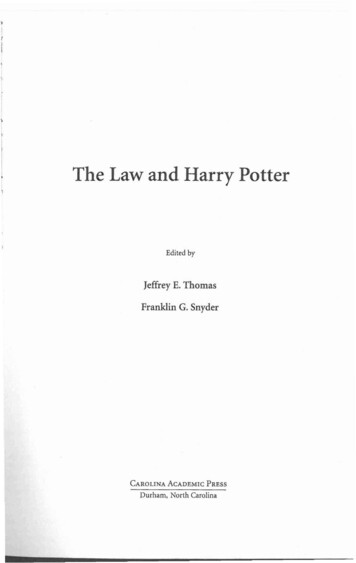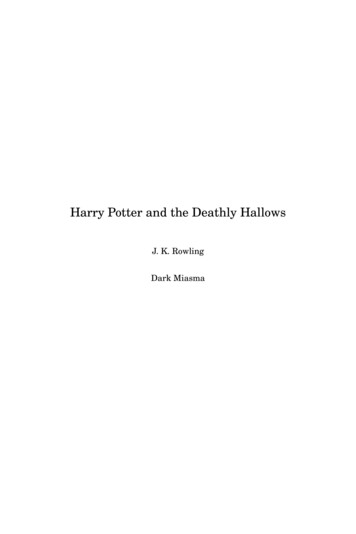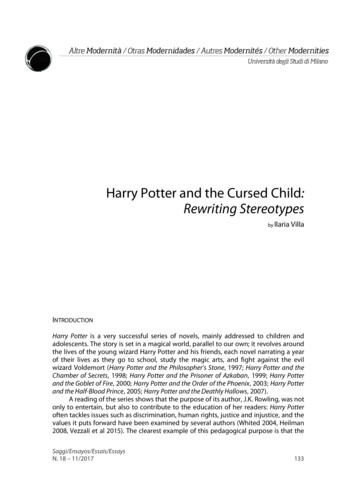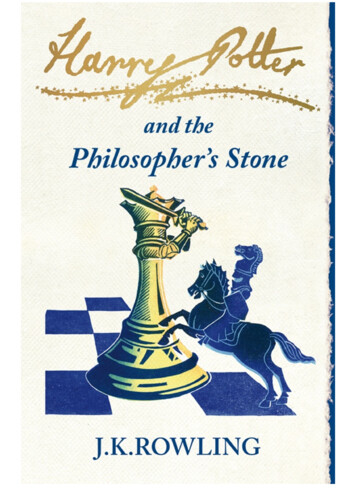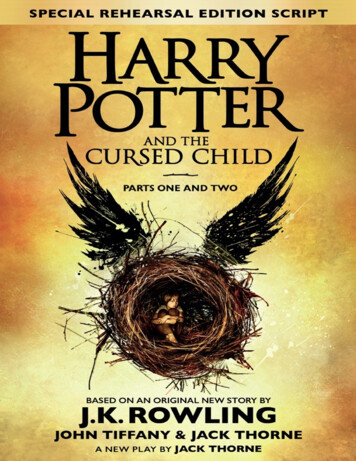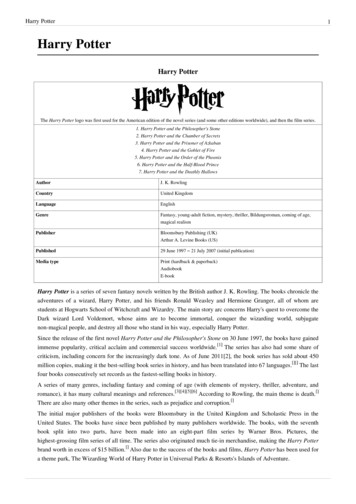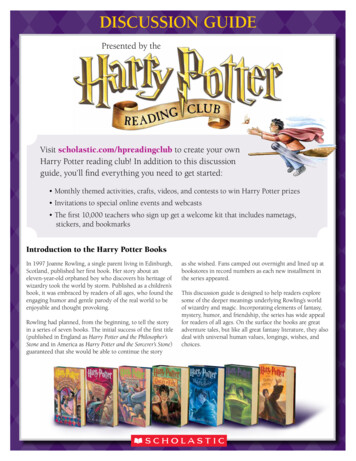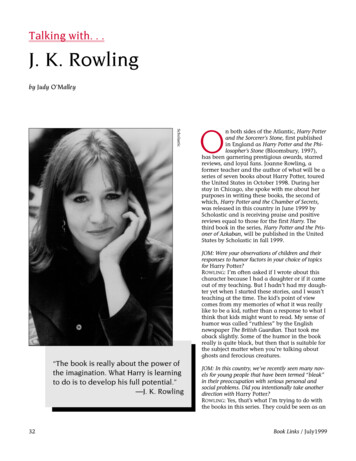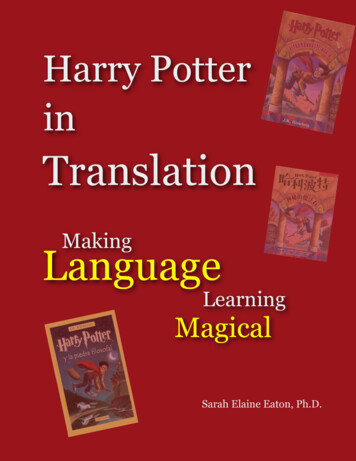
Transcription
Harry rah Elaine Eaton, Ph.D.
Harry Potter in Translation: Making Language Learning MagicalSarah Elaine EatonPublished: 2012Printed in Canada
Table of ContentsWhat is the Harry Potter in Translation Project?4Who owns all the translations?4How did the project start?4How many translations are in the collection?5How many audio recordings are there?8Is each entire book recorded?8Who did the recordings?8What are the recordings used for?9Resources for Language Teachers9Lesson Plan #1: Reading Harry Potter in Translation10Lesson Plan #2: Listening to Harry Potter in Translation12Lesson Plan #3: Guided writing activity on Harry Potter in Translation14Lesson Plan #4: Writing Fan Fiction about Harry Potter in Translation17Lesson Plan #5: Creating an Alternate Book Cover for Harry Potter inTranslation20Bibliography and Resources22
Harry Potter in Translation: Making Language Learning Magical4What is the Harry Potter in Translation Project?Researchers at the Language Research Centre at University of Calgary havecollaborated on a number of activities related to Harry Potter in Translation including:Exhibitions of the first book of J.K. Rowlingʼs Harry Potter series, Harry Potterand the Philosopherʼs Stone, translated into 70 different languages.Research presentations on translations relating to the Harry Potter books.Audio recordings of the small sections of Harry Potter and the PhilosopherʼsStone in 70 languages. Listen here: onsResearch on how to use Harry Potter in translation to teach internationallanguages to children.Who owns all the translations?The book translations are owned by the collector, Dr. Nicholas Žekulin, a professor ofRussian and a former director of the Language Research Centre, at the University ofCalgary. He lent his personal copies of the books to the research centre for the audioportion of the project. Today, he does not lend out copies of his translations from hiscollection.How did the project start?The project began in 2003 when Dr. Žekulin when he was on sabbatical in Prague andhis daughter gave him copies of the first four books in English. Then, as he travelledaround Europe, he picked up translations in various countries of the first book, HarryPotter and the Philosopherʼs Stone. That set him on a path of collecting copies of thefirst book in as many languages as he could. It took eight years to collect 70translations.Check out a video of talking about his collection and how he got started with the project:http://www.youtube.com/watch?v 6UzWqpztlIgSarah Elaine Eatonwww.drsaraheaton.com
Harry Potter in Translation: Making Language Learning Magical5How many translations are in the collection?As of December, 2011, there are about 70 different translations of Harry Potter and thePhilosopherʼs Stone in Dr. Žekulinʼs collection. These include:Translations from AsiaTranslations from the Americas1.2.3.Bengali (Bangladesh)Chinese Simplified (PRC)Chinese Traditional (Taiwan)22.23.4.5.6.7.8.Farsi (Iran)Georgian (Georgia)Gujarati (India)Hebrew (Israel)Hindi (India)Translations from Africa9.10.11.12.13.Indonesian (Indonesia)Japanese (Japan)Khmer (Cambodia)Korean (Korea)Malay (Malaysia)14.15.16.17.18.Malayalam (India)Marathi (India)Mongolian (Mongolia)Nepali (Nepal)Sinhala (Sri Lanka)19.20.21.Thai (Thailand)Urdu (Pakistan)Vietnamese (Vietnam)Sarah Elaine Eaton24.25.American English (USA)Portuguese (Brazil)Afrikaans (RSA)Arabic (Egypt)Translations from ancient languages26.27.Ancient GreekLatinwww.drsaraheaton.com
Harry Potter in Translation: Making Language Learning Magical6Translations from Europe28.29.30.Albanian (Albania)Armenian (Armenia)Asturian (Spain)31.32.33.34.Basque (France and Spain)BosnianBulgarian (Bulgaria)Catalan 9.Croatian (Croatia)Czech (Czech Republic)Danish (Denmark)Dutch (The Netherlands)Estonian (Estonia)Faroese (Faroe Islands)Finnish (Finland)French (France)Frisian (The Netherlands)Galician (Valencian) (Spain)German (Germany)Hungarian (Hungary)Icelandic (Iceland)Irish Gaelic (Ireland)Italian (Italy)Sarah Elaine 65.66.67.68.69.70.Latvian (Latvia)Russian (Russia)Lithuanian (Lithuania)Low German/Plattdeutsch (Germany)Luxemburgish (Luxembourg)Macedonian (Macedonia)Modern Greek (Greece)Norwegian (Norway)Occitan (Gascon dialect) (France)Polish (Poland)Portuguese (Portugal)Romanian (Romania)Serbian (Serbia)Slovak (Slovakia)Slovene (Slovenia)Spanish (Spain)Swedish (Sweden)Turkish (Turkey)Ukrainian (Ukraine)Welsh (Wales)West Greenlandic (Greenland)www.drsaraheaton.com
Harry Potter in Translation: Making Language Learning Magical7Did you know?.There are even differences among the Englishlanguage versions of Harry Potter. In the U.K. the firstbook went by the title Harry Potter and thePhilosopherʼs Stone.In the U.S.A. the first book wentby different title: Harry Potter andthe Sorcererʼs Stone.It is not entirely clear why thechange was made, though somescholars speculate that the U.S.publishers thought the word“philosopher” might be too difficultfor young readers, so theychanged the word to “sorcerer”.Sarah Elaine Eatonwww.drsaraheaton.com
Harry Potter in Translation: Making Language Learning Magical8How many audio recordings are there?There are audio recordings for all 70 of the translations in Dr. Žekulinʼs collection. Youcan listen to the recordings ditionsIs each entire book recorded?No. Due to copyright restrictions and laws in Canada, only the first couple of paragraphsof the first chapter of each translation were recorded. Most of the recordings are lessthan two minutes in length.Listen here:Who did the recordings?All of the recordings were done by native speakers who volunteered to take part in theproject. Scholars at the Language Research Centre intend to use the recordings forresearch projects in language teaching. Since the recordings counted as part of theresearch project, the university is obliged to keep identity of the individuals whoperformed the recordings anonymous, in order to ensure that the research project is incompliance with ethics standards for the university.Five of the volunteers chose to have their names publicized at the Harry Potter inTranslation event held at the University of Calgary on November 25, 2011. During theevent, the volunteers re-read the section of the translation that they had previouslyrecording for the live audience. These volunteers were:Ms. Livia Kivisild (Estonian)Mr. Haijo Westra (Dutch)Ms. Khaliun Batbaatar (Mongolian)Ms. Ivelina Valcheva (Bulgarian)Mr. Tanvir Ahmed (Bengali)Sarah Elaine Eatonwww.drsaraheaton.com
Harry Potter in Translation: Making Language Learning Magical9What are the recordings used for?Scholars at the university intend to use the recordings as part of research projectsrelated to teaching and learning second languages.In the fall of 2011, Dr. Rahat Naqvi brought translations of Harry Potter and thePhilosopherʼs Stone into two heritage language schools in Calgary that are members ofthe Southern Alberta Heritage Language Association (SAHLA) (http://www.sahla.ca/).Students at the Calgary Nepalese Community Association (http://calgarynepalese.ca/blog/) and at the Swedish School of Calgary (http://scancentre.ca/ and http://www.swedishschool.com/) read the first chapter of Harry Potter and the PhilosopherʼsStone in translation, together with their teachers. Students then wrote stories of theirown about the Harry Potter characters, in the target language and created their ownbook jackets for the translations.Resources for Language TeachersLanguage teachers of any of the 70 languages can use the Harry Potter in translationaudio recordings in their classes.Teachers may want to locate and then purchase a printed copy of a translation into thetarget language for class purposes. Publishers of the various translations aresearchable on the Internet.Sarah Elaine Eatonwww.drsaraheaton.com
Harry Potter in Translation: Making Language Learning Magical10Lesson Plan #1: Reading Harry Potter in TranslationGrade Levels: 3 - 12ObjectivesRead a section of Harry Potter and the Philosopherʼs Stone in a translation intothe target language. The teacher chooses the length of the section depending onthe students age and ability level. A section of not less than two paragraphs andnot more than one chapter is recommended for this lesson.Students will understand, to 75% accuracy, the story line and characters.(Students will use their existing knowledge base to help with this.)Students build reading skills and vocabulary through Harry Potter in translation.Required materialsA translation of Harry Potter and the Philosopherʼs Stone, translated into thetarget language.Board - A black board, white board or flip chart for new vocabulary words.Chalk or markers for the board.Anticipatory SetActivate the studentsʼ existing knowledge base by asking if they have read HarryPotter or seen the movies. Review charactersʼ names and story lines.Engage students in a discussion about translations of literature and movies. Askif they knew that there is a translation of Harry Potter into the target language.Tell the students that the lesson is about Harry Potter in translation.Brainstorm words the students may already know in the target languageincluding common words such as “school”, “student” and “teacher”. Challengethem to think of less common words that they may have encountered such as“magic”, “wizard” or “broom”.InstructionTeacher explains that the lesson will focus on reading Harry Potter in translation.Students will read the selection silently first.Round-robin exercise: The teacher and students will take turns reading asentence, or part of a sentence (Alternatively, the teacher can read to thestudents.)Sarah Elaine Eatonwww.drsaraheaton.com
Harry Potter in Translation: Making Language Learning Magical11Student engagementVocabularyStudents identify what words are new to them by writing them on the board. Ifapplicable, have them identify any cognates first. Then, students try to deducethe meaning of the words from the context of the text.Students look up any words they cannot figure out from the context.Students individually write down a list new vocabulary words that they wrote onthe board. They will use their list at home as part of independent practice.Analytical discussion about cultureMany of the translations of Harry Potter include words and cultural references tothe target language that are not in the original. Identify and reflect on culturalreferences in the translation.Critical thinking about translation of textsEngage students in a discussion about translation. Are there words that have notbeen translated into the target language. Why do they think that is?Closure / reviewReview new vocabulary words.Ask students what they remember from the text.Present independent practice work to be completed before next class.Independent practiceStudents each receive a copy of a short section of Harry Potter in translation toread at home. Be sure to respect local copy right laws.Using the list of vocabulary, students make up their own flash cards for each newword.Follow-up / assessmentStudents share their flash cards in class the following day and “test” one anotheron vocabulary.Review the story line in as much detail as possible in the target language.Sarah Elaine Eatonwww.drsaraheaton.com
Harry Potter in Translation: Making Language Learning Magical12Lesson Plan #2: Listening to Harry Potter in TranslationGrade Levels: 3 - 12ObjectivesStudents build listening comprehension skills by listening to a selection of HarryPotter in translation.Students will understand, to 75% accuracy, the general story line. (Students mayuse their existing knowledge base to help with this.)Materials requiredA computer with a sound card and speakers.Access to the Internet to listen to the recording(s) of Harry Potter in translation itionsOptional, but recommended: A written text of the audio selection students willhear (First 2-3 paragraphs of Chapter 1 of Harry Potter and the PhilosopherʼsStone translated.)Anticipatory setActivate the studentsʼ existing knowledge base by asking if they have read HarryPotter or seen the movies. Review charactersʼ names and story lines.Engage students in a discussion about translations of literature and movies. Askif they knew that there is a translation of Harry Potter into the target language.Tell the students that the lesson is about Harry Potter in translation.Review any previous lessons done on Harry Potter in translation.InstructionTeacher explains that the lesson will focus on reading Harry Potter in translation.If students have a copy of the written text, they read the first 2-3 paragraphs ofthe first chapter.Students read the selection silently first.Students listen to the native speaker read the translated text. Students may listeneither with or without the written text to help them.Sarah Elaine Eatonwww.drsaraheaton.com
Harry Potter in Translation: Making Language Learning Magical13Student engagementListen and repeat (Easy)Students listen to short sections of the recording and then repeat what thespeaker said exactly, trying to imitate the speakerʼs pronunciation, intonation andspeed.Reading aloud (Easy)Students pair up and read the same (or different) selections of Harry Potter intranslation to one another, focussing on pronunciation and fluency.Reviewing in pairs (Intermediate)In pairs or groups, students discuss (in the target language) what theyunderstood from the recording. This may include writing down words they heardand discussing the meaning or content.Paraphrasing aloud (Intermediate to advanced)Students paraphrase the recording in their own words.Closure / reviewReview new vocabulary words.Ask students what they remember from the audio recording.Present independent practice work to be completed before next class.Independent practiceStudents each receive a link to the web page for the Harry Potter in Translationproject so they can listen to the text again at home: onsStudents practice reading the same section of Chapter 1 of Harry Pottertranslated into the target language.Follow-up / assessmentReview the story line in as much detail as possible in the target language.Students work in pair or groups to read the same passage aloud to each other,after they have had time to practice reading aloud at home.Sarah Elaine Eatonwww.drsaraheaton.com
Harry Potter in Translation: Making Language Learning Magical14Lesson Plan #3: Guided writing activity on Harry Potter in TranslationGrade Levels: 3 - 12Note: This activity is ideally done after one of the previous reading or listening activities,as it will help to build on the skills and vocabulary that students learned during thoseactivities.ObjectivesStudents build writing skills though a guided writing activity on Harry Potter intranslation.Students will be able to complete, to 75% accuracy, the guided writing activity.Incorporate both technical elements of writing and creativity.Materials requiredA translation of Harry Potter and the Philosopherʼs Stone, translated into thetarget language.Paper and writing instruments.Anticipatory setActivate the studentsʼ existing knowledge base by reviewing what they knowabout Harry Potter. Review charactersʼ names and story lines.Review any previous activities done on Harry Potter in Translation (e.g. listeningor reading activities).Brainstorm words the students may already know in the target languageincluding common words such as “school”, “student” and “teacher”. Challengethem to think of less common words that they may have encountered such as“magic”, “wizard” or “broom”. Create a “vocabulary bank” based on their previousknowledge of this text in translation.Tell the students that the lesson is a guided writing activity on Harry Potter intranslation.Sarah Elaine Eatonwww.drsaraheaton.com
Harry Potter in Translation: Making Language Learning Magical15InstructionTeacher explains that the lesson will focus on doing a guided writing activity onHarry Potter in translation.Teacher models what the writing sample looks like.Teacher gives specific writing elements that students must include in their piecesuch as: Thematic vocabulary related to the Harry Potter books. Transitional words and phrases. Grammar and structure. The particular elements of writing will depend on the grade level andstudentsʼ abilities. Teachers adapt this aspect of the activity to theirparticular situation.Give students a choice of how they prefer to work: either in a pair, in a group of 3or 4, or independently. Establish time limit for students to make a decision andsettle on a partner or group members. A maximum of 1 or 2 minutes should beenough.Guided writing activity: Recreate the beginning of the first Harry Potter book bywriting your own unique opening for the series. This activity involves writing twoto three paragraphs. Students may substitute character names, places and drawon their own experience, if they wish. Urge them to think creatively. What if theHarry Potter series did not take place in England, but rather, in a countryassociated with the target language they are learning. How would the opening ofthe book be different?Student engagementStudents may verbally discuss their guided writing activity in the target language.This can help them organize their ideas before they write.Students actively engage in writing for a defined time period. Give studentsample time to complete their writing activity.To avoid creating anxiety, remind students that it is not critical that they finishtheir piece in the time allotted. Give students the space to think and process whatthey are doing.Teacher circulates through the room as students are writing, supporting studentsand asking them questions to prompt further creativity.Sarah Elaine Eatonwww.drsaraheaton.com
Harry Potter in Translation: Making Language Learning Magical16Closure / reviewStudents take turns reading what they have written so far. Other students offercompliments and constructive feedback.Present independent practice work to be completed before next class.Independent practiceStudents take their writing draft home with them to complete, revise andproofread it.Students check for accuracy, spelling, verb tenses and grammar.Follow-up / AssessmentStudents hand in their guided writing to the teacher for assessment based on thecriteria that were given such as use of thematic vocabulary, spelling, grammar,correct verb tenses, use of transitional words and phrases and any otherelements of writing that were previously agreed upon.Sarah Elaine Eatonwww.drsaraheaton.com
Harry Potter in Translation: Making Language Learning Magical17Lesson Plan #4: Writing Fan Fiction about Harry Potter in TranslationGrade Levels: 6 - 12ObjectivesStudents build independent writing skills by their own Harry Potter story, usingthe same characters, ideas and situations.Students incorporate their previous knowledge the target culture, by substitutingthe cultural setting of the original book with one associated with the targetlanguage. (Example: Students studying French could re-locate the story so ithappens in Québec, Haiti, France or other Francophone regions.)Materials requiredPaper and writing instruments or the appropriate technology for students to writeeffectively in the target language.Anticipatory setActivate the studentsʼ existing knowledge base by reviewing what they knowabout Harry Potter. Review charactersʼ names and story lines.Review any previous activities done on Harry Potter in Translation (e.g. listeningor reading activities).Brainstorm words the students may already know in the target languageincluding common words such as “school”, “student” and “teacher”. Challengethem to think of less common words that they may have encountered such as“magic”, “wizard” or “broom”. Create a “vocabulary bank” based on their previousknowledge of this text in translation.Tell the students that the lesson is about writing fan fiction based on Harry Potterin translation.Sarah Elaine Eatonwww.drsaraheaton.com
Harry Potter in Translation: Making Language Learning Magical18InstructionAsk the question: “What if the Harry Potter series had been set in ?”Fill in blank with examples of the regions where the target language is spoken.For languages spoken in more than one country, offer examples of a fewcountries. Otherwise, mention regions the students may know.Teacher gives specific writing elements that students must include in their piecesuch as: Thematic vocabulary related to the Harry Potter books. Transitional words and phrases. Grammar and structure. The particular elements of writing will depend on the grade level andstudentsʼ abilities. Teachers adapt this aspect of the activity to theirparticular situation.Set a time limit for students to work on their fan fiction.Tell students that their story may be set in the past or the present, but that theywill need to use the correct verb tense(s).Student engagementStudents actively engage in writing for a defined time period. Give studentsample time to complete their writing activity.To avoid creating anxiety, remind students that it is not critical that they finishtheir piece in the time allotted. Give students the space to think and process whatthey are doing.Teacher circulates through the room as students are writing, supporting studentsand asking them questions to prompt further creativity.Sarah Elaine Eatonwww.drsaraheaton.com
Harry Potter in Translation: Making Language Learning Magical19Closure / reviewStudents take turns reading what they have written so far. Other students offercompliments and constructive feedback.Present independent practice work and a deadline for completion.Independent practiceStudents continue to work on their fan fiction at home, revising it for accuracyand proof-reading it for spelling and grammar errors.Follow-up / AssessmentStudents hand in their fan fiction to the teacher for assessment based on thecriteria that were given such as use of thematic vocabulary, spelling, grammar,correct verb tenses, use of transitional words and phrases and any otherelements of writing that were previously agreed upon.Student work can be published on a class blog or included in portfolios.Sarah Elaine Eatonwww.drsaraheaton.com
Harry Potter in Translation: Making Language Learning Magical20Lesson Plan #5: Creating an Alternate Book Cover for Harry Potter in TranslationGrade Levels: 3 - 12* This activity was inspired by the work of Dr. Rahat Naqvi at the University of Calgary.ObjectivesStudents create an alternate accurate book cover of the first Harry Potter book intranslation that is culturally representative of the target language / culture.Materials requiredPaperMarkers, coloured pencils, crayons or paints.Digital alternative: Students use technology such as PowerPoint, Word or otherprograms to create their alternate book cover, such as this free tool: ractives/bookcover/)Anticipatory setActivate the studentsʼ existing knowledge base by reviewing what they knowabout Harry Potter. Review charactersʼ names and story lines.Review any previous activities done on Harry Potter in Translation (e.g. listeningor reading activities).InstructionTeacher explains that the lesson will focus on creating an alternate book coverHarry Potter in translation that is culturally accurate with the language thestudents are studying.Discuss the purpose of a book cover (e.g. give readers a clue about the story oract as an “appetizer” for the text itself).Discuss the elements of a book cover such as the title of the book, the authorʼsname and a picture or other visual elements.Say how much time students have to work on this activity in class.Sarah Elaine Eatonwww.drsaraheaton.com
Harry Potter in Translation: Making Language Learning Magical21Student engagementStudents actively engage the creation of their alternate book cover for a definedtime period. Give students ample time to work on the activity.To avoid creating anxiety, remind students that it is not critical that they finishtheir piece in the time allotted. Give students the space to think and process whatthey are doing.Teacher circulates through the room as students are creating, supporting andencouraging students and asking them questions to prompt further creativity.Closure / reviewPresent independent practice work and a deadline for completion.Independent practiceStudents continue to work on their book covers at home, adding to them untilthey are complete.Students revise and proofread the language elements of their book covers,ensuring that all the words are spelled correctly.Follow-up / AssessmentStudents hand in their alternate book covers for assessment and grading basedupon the previously discussed elements such as: correct spelling of the title andauthorʼs name, giving readers a clue about the story and any other elements thatwere previously discussed in class.Student work can be published on a class blog or included in portfolios.Sarah Elaine Eatonwww.drsaraheaton.com
Harry Potter in Translation: Making Language Learning Magical22Bibliography and ResourcesCalgary Nepalese Community Association (CNCA). (2011, December 29). Harry Potterin Nepali Language School. alilanguage-school/CBC News. (2010). Harry Potter translates into U of C display. Retrieved December29, 2011, from uages.htmlLanguage Research Centre. (2011). Harry Potter in Heritage Language Schools.Retrieved December 29, 2011, from age-language-schoolsMyers, J. (2011). Learning languages from Harry Potter. Retrieved December 29,2011, from /languagePatterson, D. (Ed.). (2009). Harry Potter's World Wide Influence. Newcastle upon Tyne,UK: Cambridge Scholars Publishing.Potkins, M. (2011). U of C puts 70 translations of Harry Potter online. Calgary Herald.Retrieved from http://www.calgaryherald.com/news/calgary/puts translations Harry Potter online/5763345/story.htmlReadWriteThink. Book Report Alternative: Creating a New Book Cover. Retrieved b-972.htmlUniversity of Calgary. (2010). Harry Potter translations on display. Retrieved December29, 2011, from http://www.youtube.com/watch?v 6UzWqpztlIgVan Wyk, A. (2009). Harry Potter's Scholarly Side. Retrieved December 29, 2011,2011, from erson.htmSarah Elaine Eatonwww.drsaraheaton.com
Lesson Plan #1: Reading Harry Potter in Translation Grade Levels: 3 - 12 Objectives Read a section of Harry Potter and the Philosopherʼs Stone in a translation into the target language. The teacher chooses the length of the section depending on the students age and abi

